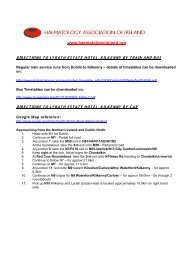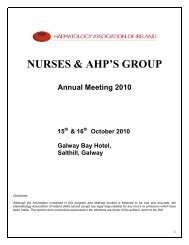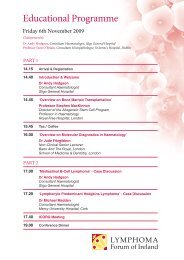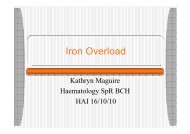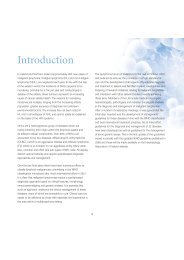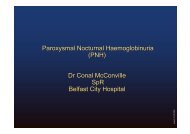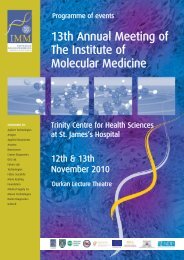Guidelines on Diagnosis and Treatment of Malignant Lymphomas
Guidelines on Diagnosis and Treatment of Malignant Lymphomas
Guidelines on Diagnosis and Treatment of Malignant Lymphomas
You also want an ePaper? Increase the reach of your titles
YUMPU automatically turns print PDFs into web optimized ePapers that Google loves.
Precursor T Cell Neoplasms<br />
PRECURSOR T LYMPHOBLASTIC<br />
LEUKAEMIA/LYMPHOBLASTIC<br />
LYMPHOMA<br />
Definiti<strong>on</strong> <strong>and</strong> Incidence<br />
Precursor T lymphoblastic leukaemia (T-ALL)/lymphoblastic<br />
lymphoma (T-LBL) is a neoplasm <strong>of</strong> T-precursor lymphoblasts<br />
with an immature immunophenotype. Patients typically present<br />
with a mediastinal mass <strong>and</strong> frequent marrow involvement. The<br />
c<strong>on</strong>diti<strong>on</strong> accounts for 15% <strong>of</strong> childhood <strong>and</strong> 25% <strong>of</strong> adult ALL.<br />
Adolescent males are the most comm<strong>on</strong>ly affected group.<br />
ICD-O Code Leukaemia: 9837/3<br />
Lymphoma: 9729/3<br />
Clinical Presentati<strong>on</strong><br />
Patients usually present with short history <strong>of</strong> increasing dyspnoea<br />
sec<strong>on</strong>dary to a rapidly-evolving mediastinal mass associated with<br />
a high leukocyte count. Other sites involved include lymph nodes,<br />
liver, spleen, skin, Waldeyer’s ring, <strong>and</strong> g<strong>on</strong>ads.<br />
Pathology<br />
The lymph node architecture is effaced by a m<strong>on</strong>omorphic<br />
populati<strong>on</strong> <strong>of</strong> lymphoblasts. The lymphoblasts are medium sized<br />
with a high nuclear–cytoplasmic ratio, irregular nuclei, fine<br />
chromatin <strong>and</strong> inc<strong>on</strong>spicuous nucleoli.<br />
Immunophenotype<br />
T-ALL/T-LBL is always TdT positive. Pan T markers including<br />
CD3, 4, 5 ,7 <strong>and</strong> 8 are variably expressed with cytoplasmic<br />
CD3 <strong>and</strong> CD7 most comm<strong>on</strong>ly expressed. Co-expressi<strong>on</strong><br />
<strong>of</strong> CD4 <strong>and</strong> CD8 may occur.<br />
Genetics<br />
One third <strong>of</strong> T-ALL/T-LBL have translocati<strong>on</strong>s involving the<br />
T-Cell Receptor (TCR) loci at 14q11 (TCR alpha <strong>and</strong> delta),<br />
7q35 (TCR beta) <strong>and</strong> 7p14 (TCR gamma). Translocati<strong>on</strong> partner<br />
chromosomes include 8q24 (MYC), 1p32 (TAL1) <strong>and</strong> others.<br />
25% <strong>of</strong> cases have TAL1 dysregulati<strong>on</strong> either by translocati<strong>on</strong> or<br />
microscopic deleti<strong>on</strong>. More than 30% have del(9p) resulting in<br />
loss <strong>of</strong> the tumour suppressor gene CDKN2A, an inhibitor <strong>of</strong> the<br />
cyclin-dependent kinase CDK4.<br />
Investigati<strong>on</strong>s<br />
Generic see page 2<br />
Specific<br />
BMA to be assessed by morphology <strong>and</strong><br />
immunophenotype. If the marrow is<br />
morphologically involved, cytogenetics<br />
are m<strong>and</strong>atory.<br />
CSF analysis to exclude meningeal disease<br />
43




